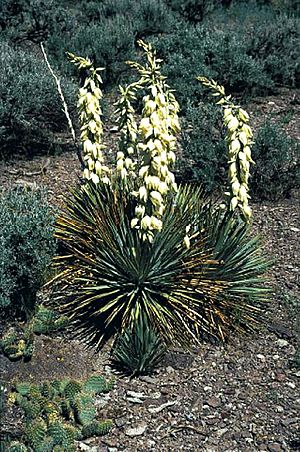Yucca harrimaniae facts for kids
Quick facts for kids Yucca harrimaniae |
|
|---|---|
 |
|
| Scientific classification | |
| Synonyms | |
|
Yucca harrimaniae, also called the Spanish bayonet, is a unique plant from the Asparagaceae family. It grows naturally in parts of the western United States. You can find it in Utah, Nevada, Colorado, northeastern Arizona, and northern New Mexico. This plant likes to grow in places that are quite high up, from about 1,000 meters (3,280 feet) to 2,700 meters (8,860 feet) above sea level.
Contents
About the Spanish Bayonet Plant
The Spanish bayonet is a small plant that doesn't have a tall stem above the ground. Instead, its leaves grow in a tight circle, like a star, right from the base. These groups of leaves are called rosettes. Over time, many of these rosettes can grow together, forming a clump of plants.
What It Looks Like
The leaves of Yucca harrimaniae are long and stiff, often with sharp points. This is why it's sometimes called the "Spanish bayonet." The flowers of this plant hang downwards, which means they are "nodding." They are usually a mix of greenish-white and purplish colors, making them quite pretty to see in their natural habitat.
Where It Grows
This yucca species is well-adapted to dry, rocky areas in the southwestern United States. It can handle different elevations, from lower desert areas to higher mountain slopes. Its ability to grow in these tough conditions shows how strong and adaptable it is.
Plant Family Connections
Yucca harrimaniae is closely related to another yucca species called Y. sterilis. Plants that are closely related often share similar features and growing habits. Scientists study these relationships to understand how different plants evolved and how they are connected.
See also
 In Spanish: Yucca harrimaniae para niños
In Spanish: Yucca harrimaniae para niños

